How to Set Activate Continuous Shoot on Nikon 1 V2
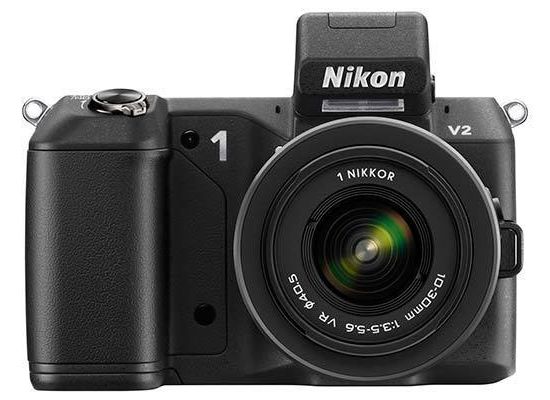
Introduction
The Nikon 1 V2 is a compact system camera featuring a new 14.2-megapixel "CX" format sensor and the Nikon 1 lens mount. Boasting continuous shooting speeds of 15fps with continuous autofocus and 60fps with fixed-point autofocus, Full 1080p HD video capture, an ultra-fast hybrid auto-focus system, Best Moment Capture and the unique Motion Snapshot Mode, the Nikon V2 also offers more conventional shooting modes like Programmed Auto, Aperture and Shutter Priority, as well as Metered Manual. Also on-board is an eye-level electronic viewfinder with a resolution of 1.44 million dots, a high resolution 3-inch LCD display with 921k dots, both an electronic and a mechanical shutter, a built-in pop-up flash, and an accessory port for attaching a flashgun, GPS unit or one of a number of accessories. Available in black or white, the Nikon 1 V2 is priced at £799 / $899 / €999.00 with a 10-30mm lens or £969 / €1,199 in a double-lens kit.
Ease of Use
The Nikon 1 V2 has undergone a rather radical redesign since the original V1 model was launched last year. The Nikon V2 now has a prominent handgrip, a prism-like hump that houses the new built-in flash unit and the EVF, and a completely revised control layout. It's subsequently an altogether more angular proposition than its much sleeker and more stylish predecessor. Still made of aluminium with magnesium alloy reinforced parts, the Nikon 1 V2 is heavier than you would think based on its size alone, weighing in at 278g body-only, but is actually slightly lighter and smaller than the V1. Thanks to the deep handgrip, which is very much like the Sony NEX series of cameras, it's now possible to shoot one-handed if you wish. Along with the prism-like hump, it does make the V2 less pocketable than the V1 though.
The V2 continues to use the relatively new Nikon 1 lens mount. Instead of being a scaled-down version of the good old F mount, it's a new design that provides 100% electronic communication between the attached lens and the camera body, courtesy of a dozen contacts. Just like on the manufacturer's F-mount SLR cameras, there is a white dot for easy lens alignment, although it has moved from the 2 o'clock position (when viewed front on) to the top of the mount. The lenses themselves feature a short silver ridge on the lens barrel, which needs to be in alignment with said dot in order for you to be able to attach the lens to the camera. While this may require a bit of getting used to, it actually makes changing lenses quicker and easier.
With no lens attached, you can see the image sensor sitting right behind the plane of the bayonet mount. Measuring 13.2x8.8mm this "CX" format imaging chip has double the surface area of the biggest sensors used in compact and bridge cameras, but only about half the area of a standard Four Thirds sensor. In linear terms, a Four Thirds chip has a 1.36x longer diagonal than the Nikon CX imager. Given that Four Thirds has a 2x focal length multiplier, the CX "crop factor" works out to about 2.72, meaning that a 10mm lens has approximately the same angle of view as a 27.2mm lens on an FX or 35mm film camera. The Nikon 1 Nikkor 10-30mm standard zoom is thus equivalent to a 27.2-81.6mm (or, practically speaking, 28-80mm) FX lens in terms of its angle-of-view range.
The rest of the Nikon V2's faceplate is almost empty, featuring only the lens release button, a receiver for the optional ML-L3 infrared remote control, an AF assist/self-timer lamp and the afore-mentioned handgrip.
There are two ways of powering on the Nikon 1 V2. You can either use the relocated on/off switch that now surrounds the shutter release button or, if you have a collapsible-barrel zoom lens attached, you can simply press the unlocking button on the lens barrel and turn the zoom ring to unlock the lens, an act that causes the camera to switch on automatically. This is an ingenious solution as you need to unlock the lens for shooting anyway. Start-up takes just over a second - nothing to write home about but still decent and entirely adequate.
You can frame your shots using either the rear screen or the electronic viewfinder (EVF). The former is a three-inch, 921,000-dot display that boasts wide viewing angles, great definition and accurate colours but only so-so visibility in strong daylight. That's where the EVF comes in. The Nikon V2 has a smooth, fluid and high-resolution electronic viewfinder with natural-looking colours, but a somewhat low magnification. Make no mistake, the finder isn't small - especially if you compare it to the OVF of a typical entry-level DSLR - but its apparent size is definitely smaller than that of the Panasonic G5, whose EVF boasts the same 1.44-million-dot resolution but a noticeably higher magnification.
The Nikon V2 also has an eye proximity sensor that allows the camera to automatically switch from the rear screen to the EVF when you raise it to your eye, but this doesn't happen instantly. There's a slight lag of about 0.5 second, which doesn't interfere that much with general shooting but can be frustrating when trying to grab a quick shot of something. The EVF has a dioptre adjustment knob on the left-hand side of the viewfinder housing, when viewed from behind.
The Nikon 1 V2 now has an entirely different control layout that's clearly been designed to appeal more to the serious enthusiast photographer. There's a new shooting mode dial on top of the camera that provides quick and easy access to the conventional P, A, S and M modes, something that the original V1 conspicuously lacked. The same dial also houses the Video, Motion Snapshot and Best Moment Capture modes, plus the green Auto mode for beginners. Also new is the tactile thumb-operated control dial which makes it much easier to set the shutter speed and aperture in the advanced shooting modes.
The F button on the rear of the camera now accesses the ISO options by default, again a big improvement on the V1 which suffered from having no direct access to this important function. Note that the operation of the F button is customisable so that you can configure it to your needs, and also that it changes operation depending upon which mode you're using - for example, in Video mode, it lets you toggle between regular and slow-motion recording.
The four-way controller on the rear has four functions mapped onto its Up, Right, Down and Left buttons, including AE/AF-Lock, exposure compensation, flash modes and self-timer, respectively. Also on the back of the camera is a thin circular scroll wheel around the four-way pad which is used to set the shutter speed in the Manual mode and select menu options. Last but not least, there are four self-explanatory buttons positioned to the left of the LCD screen, which include Playback, Menu, Display and Delete.
The Nikon V2's Scene Auto Selector is a smart auto mode in which the camera analyses the scene in front of its lens and picks what it thinks is the right mode for that particular scene. You can also choose one of the conventional PASM modes, which give you full menu access and the ability to manually set the aperture, shutter speed, or both (Program AE Shift is available in P mode).
Auto ISO comes in three flavours (Auto 160-800, 160-3200 or 160-6400), allowing you to specify how high you want the camera to go when the light gets low. You can also choose from three AF Area modes, including Auto Area, in which the camera takes control of what it focuses on (this isn't a great mode to have as your default as the camera obviously can't read your mind and may focus on something else than your actual subject); Single Point, in which you can pick one of 135 AF points by first hitting OK and then moving the active AF point around the frame using the four-way pad; and Subject Tracking, in which you pick your subject, press OK and allow the camera to track that subject as it moves around, as long as it doesn't leave the frame of course.
The Nikon 1 V2 has an intriguing hybrid auto-focus system that combines 135-point contrast- and 73-point phase-difference detection systems. This allows the Nikon 1 V2 to focus extremely quickly in good light, even on a moving subject. When light levels drop, the camera switches to contrast-detect AF which, though faster than on most cameras, isn't nearly as fast as the other method. It's always the camera that decides which AF method to use - the user has no influence on this.
Generally speaking, the V1 will usually only resort to contrast detection when light levels are low. Manual focusing is also possible, although the Nikon 1 lenses do not have focus rings. If you want to focus manually, you first have to go into the main menu, find the Focus Mode option, choose Manual Focus, press OK and then use the scroll wheel to adjust focus. To assist you with this, the Nikon V2 magnifies the central part of the image and displays a rudimentary focus scale along the right side of the frame - but those are the only focusing aids you get. There's still no peaking function available.
As noted earlier, you can choose from two different shutter types when shooting stills, mechanical or electronic. The mechanical shutter is the way to go if you shoot with flash as it can sync at shutter speeds as fast as 1/250th of a second. The Nikon 1 V2 does now has an on-board flash with a guide number of 6.3m, but it still cannot accommodate the regular Nikon Speedlights, although it is compatible with the new, tiny SB-N7 that slots into the top of the viewfinder hump. With the mechanical shutter selected, the Nikon V2 can shoot as fast as about 5 frames per second, with auto-focus. In continuous shooting mode, the EVF freezes for a split second after each shot, but with some practice, you will be able to track your subject unless it moves in a completely erratic fashion. The shutter is not very loud but you can hear the sound of the motor that's used to cock it.
In most shooting situations, you will probably want to use the electronic shutter as it's completely silent (the focus confirmation beep can be disabled from the menu), allows the use of shutter speeds as fast as 1/16,000th of a second and, with the Electronic Hi setting selected, lets you shoot full-resolution stills at 60 frames per second. Note however that while this is a major achievement, it's limited by a buffer that can only hold 40 raw files. Additionally, the use of this mode precludes AF tracking - you have to lower the frame rate to a still very fast 15fps if you want that - and the viewfinder goes blank while the pictures are being taken. About the only application we can think of where shooting full-resolution stills at 60fps could really come in handy is AE bracketing for HDR imaging. At this rate, a series of 5 bracketed shots could be taken in less than 0.1 second, rendering small movements that can otherwise pose alignment problems - like leaves being blown in the wind - a non-issue. Alas, the Nikon V2 does not offer such a feature - in fact it does not offer autoexposure bracketing at all.
The Nikon 1 V2 can be set to shoot Full HD video footage, and you even get to choose from 1080p at 30fps or 1080i at 60fps, depending on whether you prefer to work with progressive or interlaced video. If you don't need Full HD, there's also 720p at 60fps, which is really smooth and still counts as high definition. Secondly, you get full manual control over exposure in video mode. This is an option; you don't have to shoot in M mode but you can if that's what you need. Thirdly, you get fast, continuous AF in video mode, and it works well, especially in good light. Movies are compressed using the H.264 codec and stored as MOV files. There are separate shutter release buttons for stills and video, and thanks to this - as well as the massive processing power of the Nikon V2 - you can take multiple full-resolution stills even while recording HD video. This works in the other way round too - you can capture a movie clip even when the mode dial is in the Still Image position, simply by pressing the red movie shutter release. We found that in this case the camera will invariably record the video at 720p/60fps.
In addition to being capable of shooting regular movies in HD quality, the Nikon 1 V2 can also shoot video at 400fps for slow-motion playback. The resolution is lower and the aspect ratio is an ultra-widescreen 2.67:1, but the quality is adequate for YouTube, Vimeo and the like. These videos are played back at 30fps, which is more than 13x slower than the capture speed of 400fps, allowing you to get creative and show the world an array of interesting phenomena that happen too quickly to observe in real time. The Nikon V2 goes even further by offering a 1200fps video mode, but the resolution and overall quality is too poor for that to be genuinely useful.
There are two Best Moment Capture modes, with the F button toggling between them. Smart Photo Selector allows the camera to capture no less than 20 photos at a single press of the shutter release, including some that were taken before fully depressing the button. The camera analyses the individual pictures in the series and discards 15 of them, keeping only the five that it thinks are best in terms of sharpness and composition. This feature can be genuinely useful when photographing fast action and fleeting moments. The new Slow View mode captures up to 40 full-resolution continuous shots and displays them in slow motion on the LCD screen, making it easier for you to select the exact moment that you want to keep from the burst sequence.
In the innovative Motion Snapshot mode the camera records a brief high-definition movie - whose buffering starts at a half-press of the shutter release, so again includes events that had happened before the button was fully depressed - and also takes a still photograph. The movie and the still image are now saved in a single MOV file, making them much easier to share than on the V1.
The Nikon V2 stores photos and videos on SD/SDHC/SDXC memory cards, and supports the fastest UHS-I speed class. The camera runs on the new EN-EL21 Lithium-ion battery which is capable of producing less shots on a single charge than its predecessor (310 versus the V1's 350 shots). The camera's tripod socket is made of metal and is positioned in line with the lens' optical axis. This also means that changing batteries or cards is now possible while the V2 is mounted on a tripod, as the hinges of the battery/card compartment door in the new handgrip are positioned far enough away from the tripod mount.
Image Quality
All of the sample images in this review were taken using the 14 megapixel Fine JPEG setting, which gives an average image size of around 7Mb.
The Nikon 1 V2 captured images of very high quality, especially if you consider the relatively small size of its sensor and the increase from 10 to 14 megapixels. Noise is kept to a minimum, and only becomes disturbing at ISO 3200 in very low light. Colours are perhaps somewhat muted for a consumer camera but you can easily add a little punch by switching to the Vivid picture control. The Nikon 1 Nikkor 10-30mm f/3.5-5.6 VR and 1 Nikkor 30-110mm f/3.8-5.6 VR lenses both performed admirably, with good sharpness throughout the frame and negligible purple fringing. The close-up performance of the 10-30mm lens is surprisingly good. The night shot came out well even with long-exposure noise reduction switched off, and the Vibration Reduction feature of the lenses worked very well.
Noise
The base sensitivity of the Nikon 1 V2 is ISO 160 and the highest setting is ISO 6400. The 100% crops below show what the quality is like at each setting for both JPEG and RAW file formats.
| JPEG | RAW |
| ISO 160 (100% Crop) | ISO 160 (100% Crop) |
 |  |
| ISO 200 (100% Crop) | ISO 200 (100% Crop) |
 |  |
| ISO 400 (100% Crop) | ISO 400 (100% Crop) |
 |  |
| ISO 800 (100% Crop) | ISO 800 (100% Crop) |
 |  |
| ISO 1600 (100% Crop) | ISO 1600 (100% Crop) |
 |  |
| ISO 3200 (100% Crop) | ISO 3200 (100% Crop) |
 |  |
| ISO 6400 (100% Crop) | ISO 6400 (100% Crop) |
 |  |
Sharpening
The out-of-camera JPEGs are quite sharp but still benefit from a little sharpening in a program like Adobe Photoshop.
| Original (100% Crop) | Sharpened (100% Crop) |
 |  |
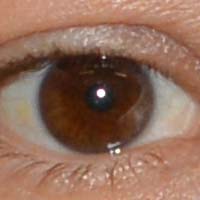 | 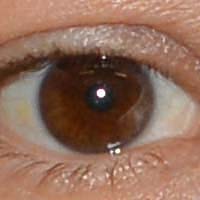 |
File Quality
The JPEG quality settings available on the Nikon V2 include Basic, Normal and Fine. The camera can also save photos in Nikon's proprietary raw file format, NEF.
| Fine (6.99Mb) (100% Crop) | Normal (3.95Mb) (100% Crop) |
 |  |
| Basic (1.64Mb) (100% Crop) | RAW (13.0Mb) (100% Crop) |
 |  |
Flash
The flash settings on the Nikon 1 V2 are Fill flash, fill flash + slow sync, red-eye reduction, red-eye reduction + slow sync, rear-curtain sync, rear curtain + slow sync. These shots of a white coloured wall were taken at a distance of 1.5m.
| Flash Off - Wide Angle (28mm) | Flash On - Wide Angle (28mm) |
 |  |
| Flash Off - Telephoto (80mm) | Flash On - Telephoto (80mm) |
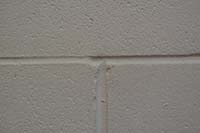 |  |
And here are a couple of portrait shots. Both the Auto setting and the Red-eye reduction mode caused a small amount of red-eye.
| Flash On | Flash On (100% Crop) |
 |  |
| Red-eye reduction | Red-eye reduction (100% Crop) |
 | 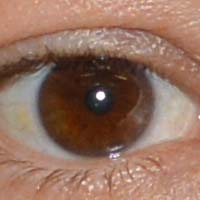 |
Night
The Nikon V2 has a minimum shutter speed of 30 seconds, with a Bulb setting also available for really long exposures. The shot below was captured at a shutter speed of 15 seconds, aperture of f/6.3 at ISO 160. We have provided a 100% crop to show you what the quality is like. Note that long-exposure noise reduction was switched off for this shot.
| Night Shot | Night Shot (100% Crop) |
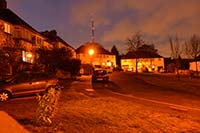 |  |
Vibration Reduction
The Nikon 1 V2 does not offer body-integral image stabilisation, but the kit lens bundled with the camera features Vibration Reduction, Nikon's proprietary lens-based optical stabilisation system. This allows you to take sharp hand-held photos at slower shutter speeds than with lenses that lack this function. To illustrate this, I took two photos at the 28 and 80mm focal lengths, one with VR and another without. You can see that this feature really works and could mean the difference between a ruined shot and a sharp capture. Note that even though VR is lens-based, you need to activate it via the camera's menu as the lenses do not feature a VR switch. The available VR modes are Normal, Active and Off.
| Shutter Speed / Focal Length | Vibration Reduction Off (100% Crop) | Vibration Reduction On (100% Crop) |
| 1/6 sec / 28mm |  | 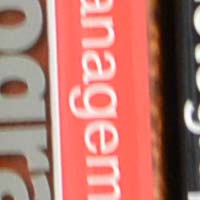 |
| 1/8 sec / 80mm |  |  |
Active D-Lighting
Active D-lighting is Nikon's dynamic range optimisation tool that attempts to squeeze the full dynamic range of the sensor into JPEGs. On the Nikon 1 V2, the strength of the effect cannot be modified by the user. The only available settings are on and off.
| Off | On |
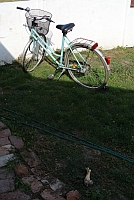 | 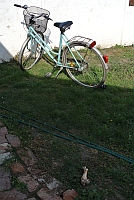 |
Picture Controls
Nikon's Picture Controls, similarly to Canon's Picture Styles, are preset combinations of different contrast and saturation settings. The available Picture Controls are Standard, Vivid, Neutral, Monochrome, Portrait and Landscape. The following series demonstrates the differences across these settings.
| Standard | Neutral |
 | 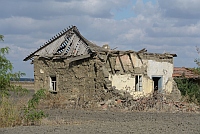 |
| Vivid | Monochrome |
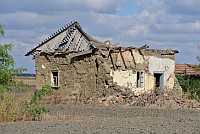 | 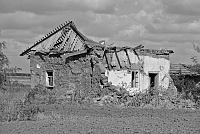 |
| Portrait | Lansdscape |
 | 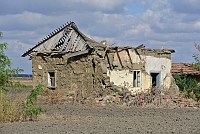 |
Sample Images
This is a selection of sample images from the Nikon 1 V2 camera, which were all taken using the 14 megapixel Fine JPEG setting. The thumbnails below link to the full-sized versions, which have not been altered in any way.
Sample RAW Images
The Nikon 1 V2 enables users to capture RAW and JPEG format files. We've provided some Nikon RAW (NEF) samples for you to download (thumbnail images shown below are not 100% representative).
Sample Movie & Video
This is a sample movie at the highest quality setting of 1920x1080 pixels at 30 frames per second. Please note that this 20 second movie is 51.6Mb in size.
Product Images
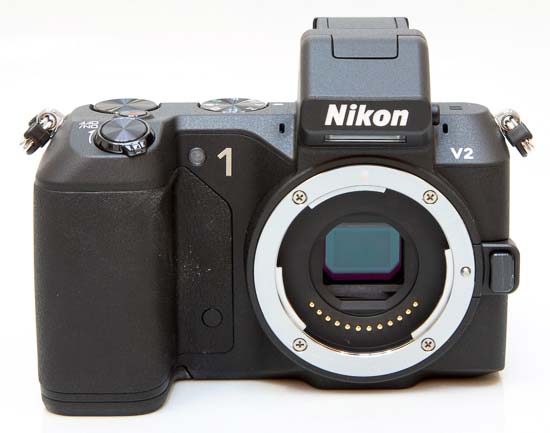 |
| Front of the Camera |
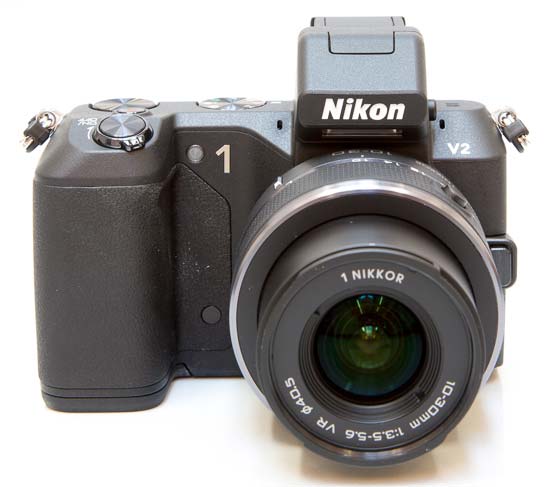 |
| Front of the Camera / Lens Fitted |
 |
| Front of the Camera / Pop-up Flash |
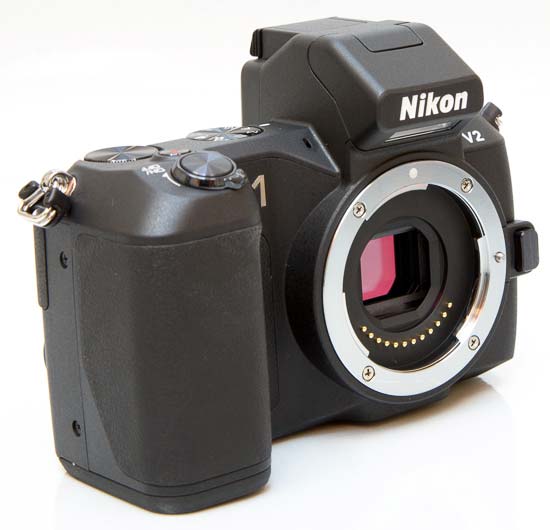 |
| Isometric View |
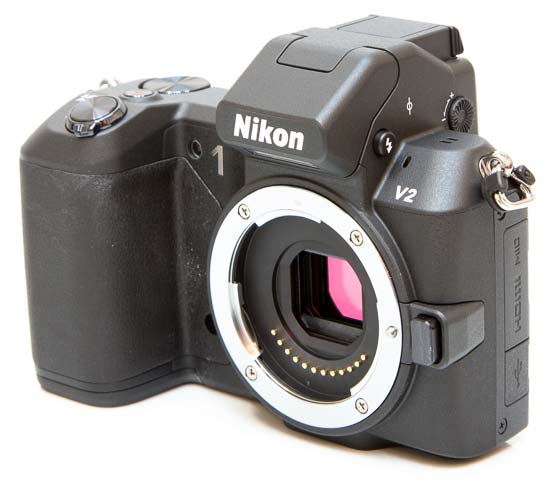 |
| Isometric View |
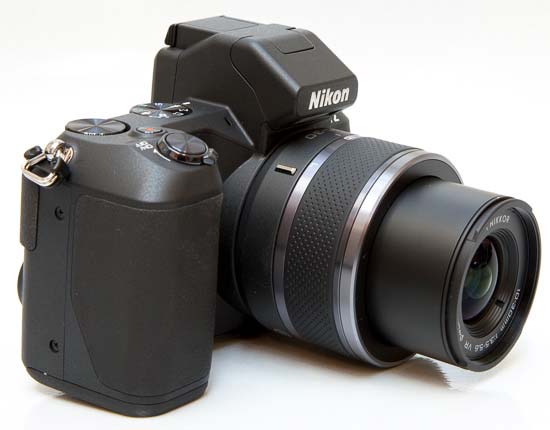 |
| Isometric View |
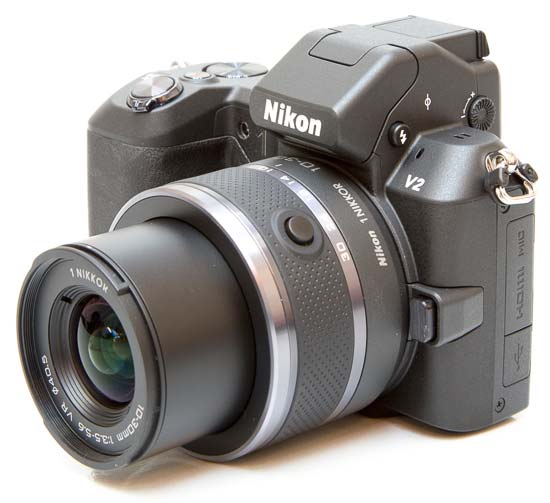 |
| Isometric View |
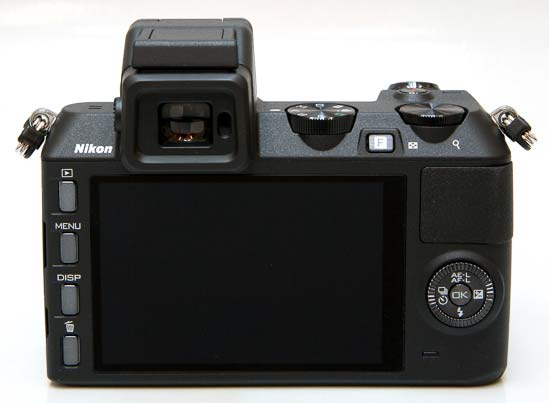 |
| Rear of the Camera |
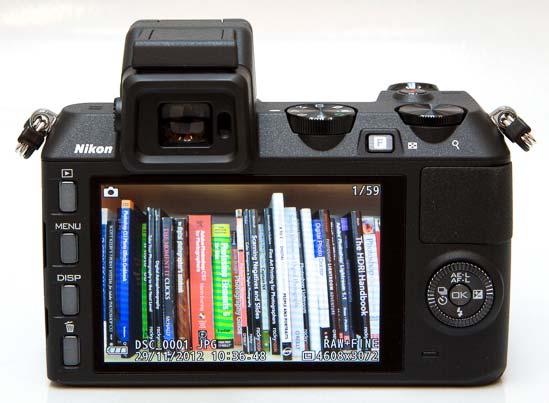 |
| Rear of the Camera / Image Displayed |
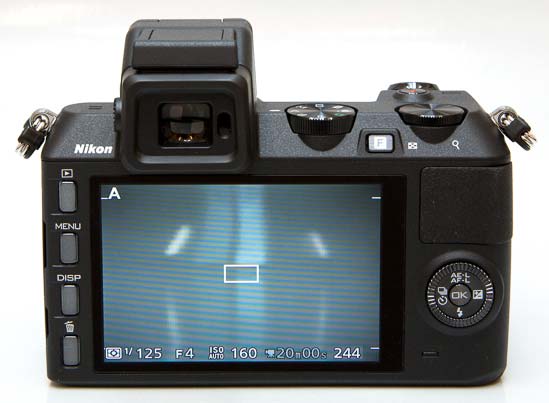 |
| Rear of the Camera / Turned On |
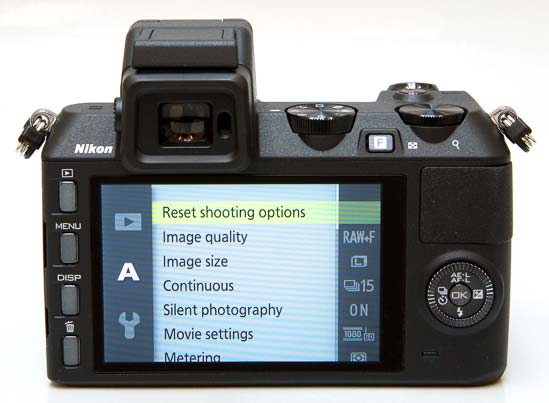 |
| Rear of the Camera / Main Menu |
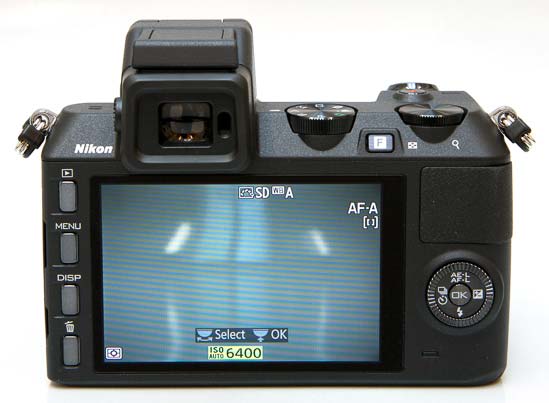 |
| Rear of the Camera / F Menu |
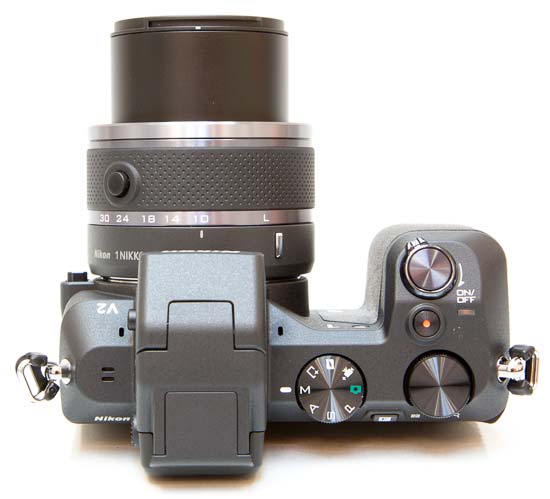 |
| Top of the Camera |
 |
| Bottom of the Camera |
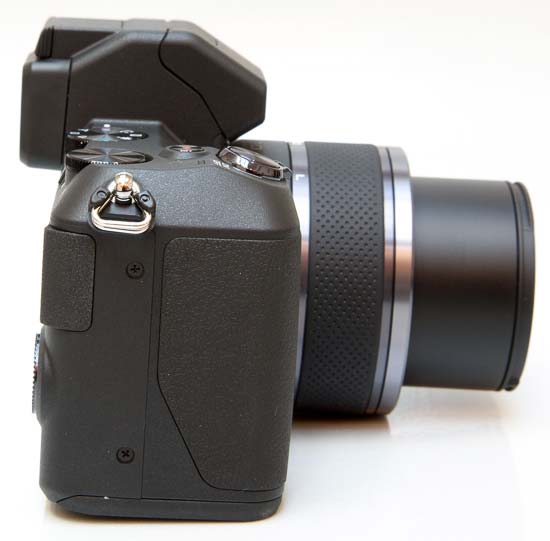 |
| Side of the Camera |
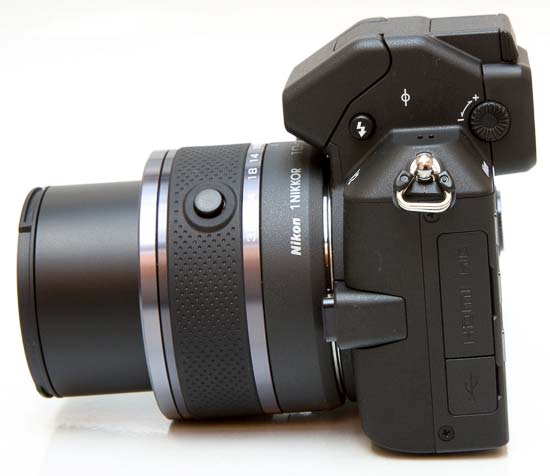 |
| Side of the Camera |
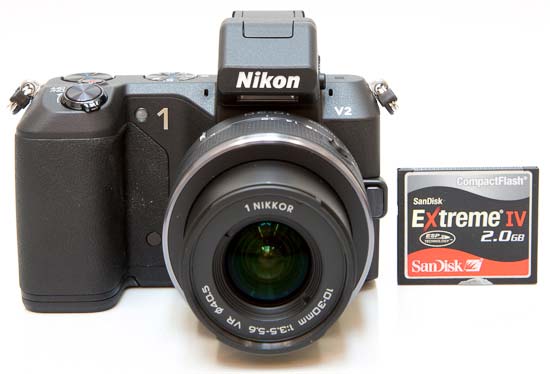 |
| Front of the Camera |
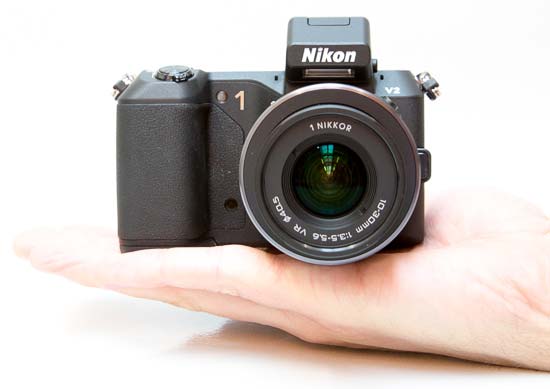 |
| Front of the Camera |
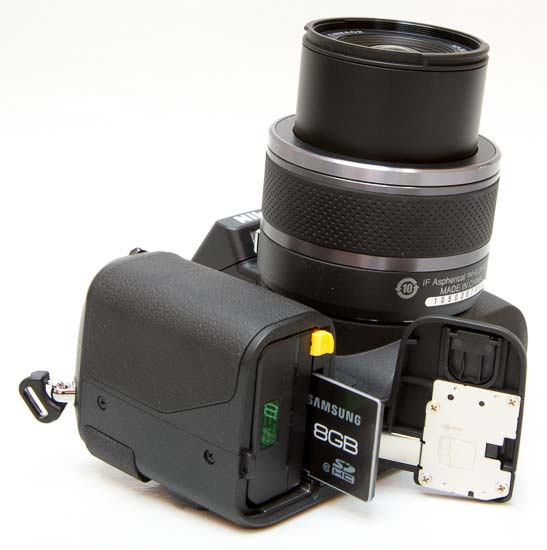 |
| Memory Card Slot |
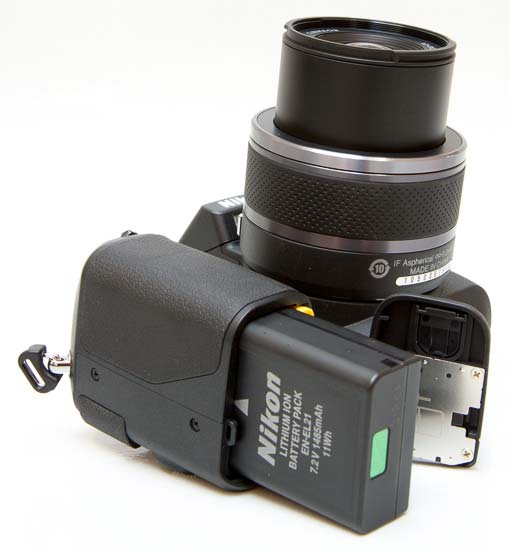 |
| Battery Compartment |
Conclusion
Nikon have made some big changes to the original V1 to make this new model more appealing to keen enthusiasts, and in most regards they've succeed in making the new V2 a much more serious proposition. The new handgrip, shooting mode dial and control dial in particular make the V2 quicker to use, while the pop-up flash makes it more versatile, albeit at the expense of the V1's stylish and slimline appearance. We're also pleased to see the high image quality has been maintained despite a big jump in the megapixel count, although the high price tag of £799 / $899 is still rather eye-watering for a camera with such a small sensor.
In good light the Nikon V2 is still as fast as anything on the market when it comes to auto-focus speed. Even if you compare it to pro SLR cameras with fast-focusing lenses, the Nikon 1 V2 comes out favourably, both in terms of sheer speed and accuracy. Its headline-grabbing 60fps burst mode might not be quite as useful as it may sound, but the fact that it can also shoot at 15fps and keep the subject in focus is pretty sensational, especially if you consider that we are talking about a camera that's quite a lot smaller than a typical SLR. On the other hand, low-light focusing is still less than stellar, and there are some other areas of performance where there's still room for improvement.
Nikon have clearly gone back to the drawing board in order to differentiate the V2 from the entry-level J1 model, with the V2 now offering an attractive combination of speed, portability, image quality and handling that's geared more to the serious photographer, rather than to the consumer upgrading from a point and shoot compact. It may not be as small and stylish as the original V1, but the new Nikon 1 V2 is definitely a more serious proposition than its predecessor.
| Ratings (out of 5) | |
|---|---|
| Design | 4 |
| Features | 4.5 |
| Ease-of-use | 4.5 |
| Image quality | 4.5 |
| Value for money | 3 |
Review Roundup
Reviews of the Nikon 1 V2 from around the web.
The Nikon 1 V2 is the flagship model in the Nikon 1 system of Mirrorless cameras. The system comprises of a new electric lens-mount paired with a 3:2 aspect ratio sensor having a 2.7X crop factor. This makes it possible to shrink Nikon 1 cameras and lenses compared to all but one Mirrorless system.
Read the full review »
Specifications
| Type | Digital camera with support for interchangeable lenses |
| Lens mount | Nikon 1 mount |
| Effective angle of view | Approx. 2.7x lens focal length (35 mm format equivalent) |
| Effective pixels | 14.2 million |
| Image sensor | 13.2 mm x 8.8 mm CMOS sensor (Nikon CX format) |
| Dust-reduction system | Image sensor cleaning |
| Image size (pixels) | Still images (auto, P, S, A, M, best moment capture modes; aspect ratio 3 : 2): 4608 x 3072, 3456 x 2304, 2304 x 1536; Still images (advanced movie mode; aspect ratio 3 : 2):4608 x 3072 (1080/60i, 1080/30p), 1280 x 856 (720/60p, 720/30p); Still images (Motion Snapshots; aspect ratio 16 : 9): 4608 x 2592 |
| File format | NEF (RAW): 12-bit, compressed; JPEG: JPEG-Baseline compliant with fine (approx. 1 : 4), normal (approx. 1 : 8), or basic (approx. 1 : 16) compression; NEF (RAW) + JPEG: Single photograph recorded in both NEF (RAW) and JPEG formats |
| Picture Control system | Standard, Neutral, Vivid, Monochrome, Portrait, Landscape; selected Picture Control can be modified; storage for custom Picture Controls |
| Media | SD (Secure Digital), SDHC, and SDXC memory cards |
| File system | DCF (Design Rule for Camera File System) 2.0, DPOF (Digital Print Order Format), Exif (Exchangeable Image File Format for Digital Still Cameras) 2.3, PictBridge |
| Electronic viewfinder | 0.47-in., approx. 1440k-dot color TFT LCD viewfinder with diopter control and brightness adjustment |
| Frame coverage | Approx. 100% horizontal and 100% vertical |
| Eyepoint | 18 mm (-1.0 m-1; from center surface of viewfinder eyepiece lens) |
| Diopter adjustment | -3 - +2 m-1 |
| Eye sensor | Camera switches to viewfinder display when it detects that viewfinder is in use |
| Shooting modes | Auto, P (programmed auto), S (shutter-priority auto), A (aperture-priority auto), M (manual), best moment capture (slow view and Smart Photo Selector), advanced movie (HD and slow motion), Motion Snapshot |
| Shutter type | Electronically-controlled vertical-travel focal-plane mechanical shutter; electronic shutter |
| Shutter speed | Mechanical shutter: 1/4000-30 s in steps of 1/3 EV; Bulb; Time (requires optional ML-L3 remote control); Electronic shutter: 1/16,000-30 s in steps of 1/3 EV; Bulb; Time (requires optional ML-L3 remote control); Note: Bulb and Time end automatically after approximately 2 minutes |
| Flash sync speed | Mechanical shutter: Synchronizes with shutter at X=1/250 s or slower; Electronic shutter: Synchronizes with shutter at X=1/60 s or slower |
| Release mode | Single frame, continuous, self-timer, remote |
| Frame advance rate | Approximately 5, 15, 30, or 60 fps |
| Self-timer | 2 s, 10 s |
| Remote control modes | Delayed remote (2 s); quick-response remote |
| Exposure metering | TTL metering using image sensor |
| Exposure metering method | Matrix; Center-weighted: Meters 4.5 mm circle in center of frame; Spot: Meters 2 mm circle centered on selected focus area |
| Exposure mode | P (programmed auto with flexible program); S (shutter-priority auto); A (aperture-priority auto); M (manual); scene auto selector |
| Exposure compensation | -3 - +3 EV in increments of 1/3 EV (user controlled in P, S, and A modes) |
| Exposure lock | Luminosity locked at metered value with AE-L/AF-L button |
| ISO sensitivity (Recommended Exposure Index) | ISO 160-6400 in steps of 1 EV; auto ISO sensitivity control (ISO 160-6400, 160-3200, 160-800) available (user controlled in P, S, A, and M modes) |
| Active D-Lighting | On, off |
| Autofocus | Hybrid autofocus (phase detection/contrast-detect AF); AF-assist illuminator |
| Lens servo | Autofocus (AF): Single AF (AF-S); continuous AF (AF-C); auto AF-S/AF-C selection (AF-A); full-time AF (AF-F); Manual focus (MF) |
| AF-area mode | Single-point, auto-area, subject tracking |
| Focus area | Single-point AF: 135 focus areas; the center 73 areas support phase-detection AF; Auto-area AF: 41 focus areas |
| Focus lock | Focus can be locked by pressing shutter-release button halfway (single AF) or by pressing AE-L/AF-L button |
| Face priority | On, off |
| Built-in flash | Raised by pressing flash button |
| Guide Number (GN) | Approx. 5/16 (m/ft, ISO 100, 20 °C/68 °F; at ISO 160, Guide Number is approx. 6.3/20.7) |
| Flash control | i-TTL flash control using image sensor |
| Flash mode | Fill flash, fill flash + slow sync, red-eye reduction, red-eye reduction + slow sync, rear-curtain sync, rear curtain + slow sync |
| Flash compensation | -3 - +1 EV in increments of 1/3 EV |
| Flash-ready indicator | Lights when flash is fully charged |
| White balance | Auto, incandescent, fluorescent, direct sunlight, flash, cloudy, shade, preset manual, all except preset manual with fine tuning |
| Movie metering | TTL metering using image sensor |
| Movie metering method | Matrix; Center-weighted: Meters 4.5 mm circle in center of frame; Spot: Meters 2 mm circle centered on selected focus area |
| Frame size (pixels)/recording rate | HD movies and movies recorded in auto, P, S, A, and M modes (aspect ratio 16 : 9): 1920 x 1080/60i (59.94 fields/s *), 1920 x 1080/30p (29.97 fps), 1280 x 720/60p (59.94 fps), 1280 x 720/30p (29.97 fps); Slow-motion movies (aspect ratio 8 : 3): 640 x 240/400 fps (plays at 30p/29.97 fps), 320 x 120/1200 fps (plays at 30p/29.97 fps); Motion Snapshot (aspect ratio 16 : 9): 1920 x 1080/60p (59.94 fps) (plays at 24p/23.976 fps) * Sensor output is about 60 fps. |
| File format | MOV |
| Video compression | H.264/MPEG-4 Advanced Video Coding |
| Audio recording format | AAC |
| Audio recording device | Built-in or optional external ME-1 stereo microphone; sensitivity adjustable |
| Monitor | 7.5 cm (3-in.), approx. 921k-dot, TFT LCD with brightness adjustment |
| Playback | Full-frame and thumbnail (4, 9, or 72 images or calendar) playback with playback zoom, movie playback, slide show, histogram display, auto image rotation, and rating option |
| USB | Hi-Speed USB |
| HDMI output | Type C mini-pin HDMI connector |
| Multi accessory port | Used for designated accessories |
| Audio input | Stereo mini-pin jack (3.5 mm diameter) |
| Supported languages | Arabic, Chinese (Simplified and Traditional), Czech, Danish, Dutch, English, Finnish, French, German, Greek, Hindi, Hungarian, Indonesian, Italian, Japanese, Korean, Norwegian, Polish, Portuguese (European and Brazilian), Romanian, Russian, Spanish, Swedish, Thai, Turkish, Ukrainian, Vietnamese |
| Battery | One rechargeable Li-ion EN-EL21 battery |
| AC adapter | EH-5b AC adapter; requires EP-5D power connector (available separately) |
| Tripod socket | 1/4-in. (ISO 1222) |
| Dimensions (W x H x D) | Approx. 107.8 x 81.6 x 45.9 mm (4.2 x 3.2 x 1.8 in.), excluding projections; thickness of body (from mount to monitor) is 33.2 mm (1.3 in.) |
| Weight | Approx. 338 g (11.9 oz) with battery and memory card but without body cap; approx. 278 g (9.8 oz), camera body only |
| Temperature | 0 °C-40 °C (+32 °F-104 °F) |
| Humidity | 85% or less (no condensation) |
| Supplied accessories | EN-EL21 rechargeable Li-ion battery (with terminal cover), MH-28 battery charger, BF-N1000 body cap, BS-N3000 multi accessory port cover, UC-E19 USB cable, AN-N1000 strap, ViewNX 2/Short Movie Creator CD, User's Manual, Reference manual CD |
Your Comments
- Introduction
- Ease of Use
- Image Quality
- Sample Images
- Product Images
- Conclusion
- Review Roundup
- Specifications
alexanderandee1958.blogspot.com
Source: https://www.photographyblog.com/reviews/nikon_1_v2_review
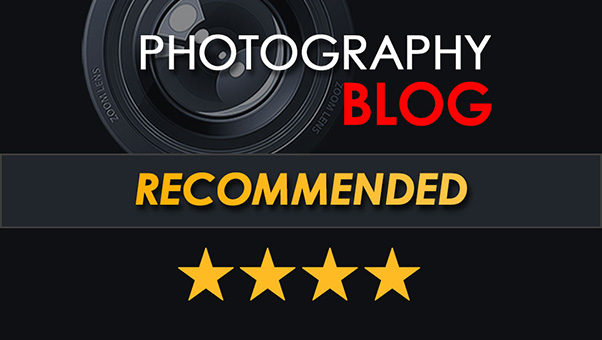
0 Response to "How to Set Activate Continuous Shoot on Nikon 1 V2"
Post a Comment